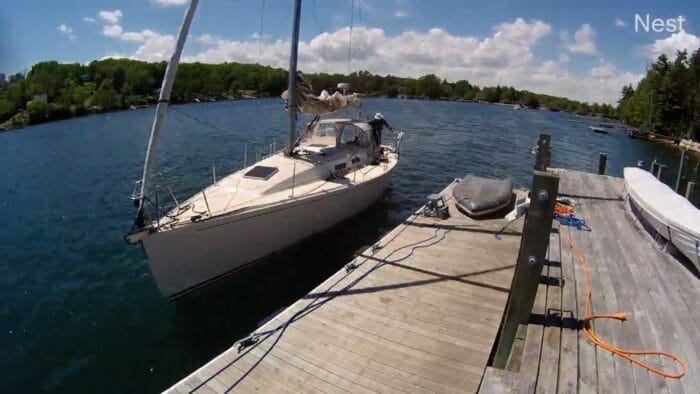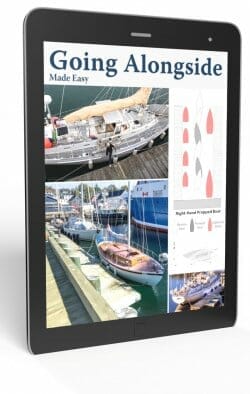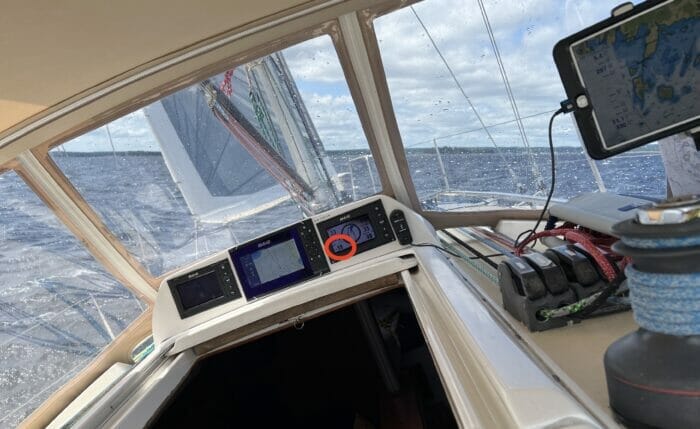
I was out sailing singlehanded a couple of days ago. When I got back into our cove I, as usual when I’m planning to return to our wharf, dropped and furled the mainsail after starting the engine.
But then it struck me that it might be fun to see if I could get alongside without using the engine, so I shut it down.
The wind was blowing into the inlet where our wharf is so it would have been pretty easy to just dock bow downwind…or maybe not…read on.
But being a bit of a wisenheimer, I thought, nah, that would mean then turning the boat around into her normal bow-out position.
I had about 15 knots of wind from pretty much aft, although gusty, and that quickly brought the boat up to 2.5 knots driven by just the windage of the spar, furled sails, and dodger. Faster than I expected.
On the way down the inlet I made a couple of 180° turns upwind and learned she would come into the eye of the wind and carry her way for about a boat length—always worth testing these things before we have hard stuff in the way.
On my first pass I turned too late and ran out of way before getting near enough to the wharf to get on it safely—only idiots jump.
So I had to start the engine and back off. But I was real close to success, so I motored upwind a few hundred yards and set up to try again.
Second time I nailed it.
Here’s what I learned:
- Yes, the J/109 is agile and slippery, but any reasonably good sailboat can get up enough speed downwind under bare poles to steer well and turn into the wind to stop.
- If the boat won’t get enough speed under bare poles, just unroll a bit of jib.
- But roll it up before making the turn; if we leave it out the boat will accelerate in the turn and, worse still, the bow might blow off.
- When docking upwind with no power step off with the magic spring and bow line first.
- The magic spring can be used to slow the boat and then run forward to stop her drifting aft.
- (I used a line on the dock for the slow down, which made it easier single handed.)
- Then use the bow line to stop the bow from swinging off the wharf.
- The magic spring can be used to slow the boat and then run forward to stop her drifting aft.
- If docking downwind, use the magic spring and stern line but be careful as:
- Two knots is way too fast to get on the wharf safely.
- Bleeding off that much momentum with a line round a cleat could get us hurt—I wouldn’t try that, even with a light boat like the J/109.
- The biggest danger is being too slow, or leaving the turn until too late, so the bow may get blown off to leeward and hit the dock.
- If we think we are slow, better to make the abort call early and turn the bow away from the wharf before we lose all steerage.
- Also, on balance, better to be too fast and have momentum to abort, rather than too slow.
- While practising it makes sense to have the engine running in neutral, or at least warmed up. This saved me on the first approach.
- I have a pile of experience with this boat and handling boats without engines from my one-design sailing days but even so I screwed up the first one.
- With two people this would be verging on easy, even in a bigger boat, for one it’s challenging.
- I would not try this single handed on a much bigger boat.
- Be careful and mindful, a stupid move could get us hurt badly.
- Sailing under bare poles is a skill that could get us out of some very deep yogurt in the event of an engine failure.
- This is a way less fraught technique than making the docking with sails still up.
- If you are thinking of taking the Yachtmaster exam, handling simulated engine failures and manoeuvring under sail are required skills.
- This kind of experimentation will equip us to be safe and competent cruisers way more than…a huge amount of knowledge about lithium batteries.
- More fun too.
I liked the bare poles way so much that I’m thinking that when single handed I will use it to pick up the mooring, since steering, dropping the sail, and grabbing the mooring all at once can get a tad busy—I missed it three times in a row one day last week.
Here’s a short clip of my second approach:
- Because of the camera angle and jumpy video the approach looks faster than it was:
- At the start of the approach I was doing 2.3 knots.
- When we came alongside we were down to less than one knot.
- I did not rig fenders since they are permanently on our floating wharf.
- Sorry about the quality, it’s from our dock Nest camera.
Further Reading:



